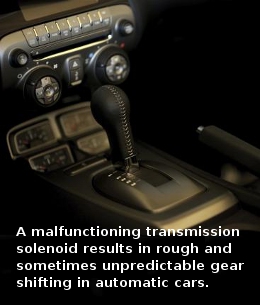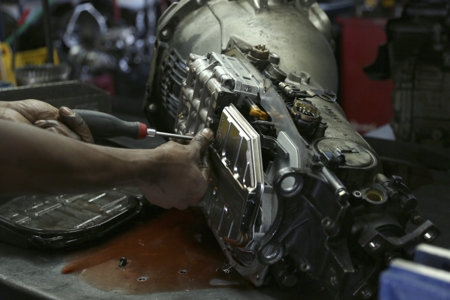
Quick checkYou can check whether a particular transmission solenoid is faulty or not with the help of the following simple setup. You will need a 10 ohm high wattage ceramic resistor and a test headlight. Connect the headlight and the resistor in series with the 12v car battery. If the headlight glows dim or not at all, then the solenoid is faulty.If the engine is the heart of a car, then the gears are definitely its muscles. An athlete with a big heart still won’t be able to win a race if his muscles are torn. Similarly, the massive amounts of power generated by your car’s engine won’t amount to anything if its transmission is faulty.Automatic cars have transmission solenoids to control gear engagement and disengagement without human intervention. A bad transmission solenoid can result in the malfunctioning of the entire transmission system. As such, it is important to understand its working within the transmission control unit of your car, and therefore be able to know when it is not functioning correctly.What is a Transmission Solenoid and What Does it Do?The transmission solenoid is an electromechanical element. To understand its working, first, we must understand how a solenoid works.A solenoid works on the principle of electromagnetism. In its most basic form, a solenoid is a cylindrical coil of wire which acts as a magnet (electromagnet) when electricity is allowed to pass through it. It can be used as a switch to attract or repel valves within a system, opening or closing them respectively. Automatic transmissions in modern cars rely on a complex hydraulic system to apply the clutch and change the gears. This entire system is controlled electronically by a micro-controller chip using the aforementioned transmission solenoids. These solenoids control the valves, opening/closing them according to the respective signals given by the micro-controller. They control the flow of the pressurized fluid within the various parts of the hydraulic transmission module. The micro-controller accurately controls this fluid flow by precisely timing the opening and closing of the solenoid valves, allowing for a smooth, effortless gear shift.Bad Transmission Solenoid SymptomsConsidering the complexity of the automatic transmission control units of cars, identifying a fault in one the solenoids within them might seem like a daunting task! However, there are certain specific symptoms that you could look out for, which can make the job of diagnosing and troubleshooting a bad transmission solenoid easier.
Automatic transmissions in modern cars rely on a complex hydraulic system to apply the clutch and change the gears. This entire system is controlled electronically by a micro-controller chip using the aforementioned transmission solenoids. These solenoids control the valves, opening/closing them according to the respective signals given by the micro-controller. They control the flow of the pressurized fluid within the various parts of the hydraulic transmission module. The micro-controller accurately controls this fluid flow by precisely timing the opening and closing of the solenoid valves, allowing for a smooth, effortless gear shift.Bad Transmission Solenoid SymptomsConsidering the complexity of the automatic transmission control units of cars, identifying a fault in one the solenoids within them might seem like a daunting task! However, there are certain specific symptoms that you could look out for, which can make the job of diagnosing and troubleshooting a bad transmission solenoid easier.
It is important to realize that the faults in your car’s transmission can either be electronic or mechanical. In most cases, they can be easily distinguished.
A fault in the electronics is usually self-diagnosed by the car’s MCU, which lights up the Check Engine indicator on your dashboard. The best option then is to take your car to a certified mechanic and have its computer scanned for the OBD codes. OBD is an acronym for On-Board Diagnostics Parameter IDs. These are standard codes which are generated by the car’s computer when it detects a problem. Identifying these codes should enable you to find the problem in your car’s transmission. Note that there are specific codes for the malfunctioning transmission solenoids.Problems with the mechanical parts of the transmission―in the hydraulics modulevare usually accompanied by the following symptoms: Rough Shifting: The transmission of your car should ideally be so smooth that it should happen without you being aware of it. If you are experiencing roughness during shifting of gears, it is most likely because of too much fluid pressure in the hydraulics. This could be because of a malfunctioning transmission solenoid.Shifting Delay: Gear shifting happens in two stages: activation of clutch, followed by engagement of the gear. In a properly functioning transmission, this happens almost instantaneously. Hence, if you happen to notice that the gears in your car don’t engage on time, causing there to be some delay during which your car behaves as if it were in neutral, then it is most likely that your car has a bad transmission shift solenoid.Faulty Down Shift: If your car continues to rev even when you apply the brakes, and rolls forward slightly when you bring it to a stop, then too you are dealing with a faulty down-shifting transmission mechanism.Random Unpredictable Gear-Shifts: A correctly functioning automatic transmission shifts to higher gears when your car’s speed has increased, and to lower gears when it decreases. If your car refuses to down shift, randomly jumps to higher gears, or skips gears during acceleration, then the solenoids need to be checked.Sometimes, it is possible that the entire solenoid pack within your car is malfunctioning. This is associated with symptoms such as delayed gear engagement, hard gear shifts, reverse gear shift issues, and sometimes even no gear changes.How to Fix a Bad Transmission Solenoid Issue
Rough Shifting: The transmission of your car should ideally be so smooth that it should happen without you being aware of it. If you are experiencing roughness during shifting of gears, it is most likely because of too much fluid pressure in the hydraulics. This could be because of a malfunctioning transmission solenoid.Shifting Delay: Gear shifting happens in two stages: activation of clutch, followed by engagement of the gear. In a properly functioning transmission, this happens almost instantaneously. Hence, if you happen to notice that the gears in your car don’t engage on time, causing there to be some delay during which your car behaves as if it were in neutral, then it is most likely that your car has a bad transmission shift solenoid.Faulty Down Shift: If your car continues to rev even when you apply the brakes, and rolls forward slightly when you bring it to a stop, then too you are dealing with a faulty down-shifting transmission mechanism.Random Unpredictable Gear-Shifts: A correctly functioning automatic transmission shifts to higher gears when your car’s speed has increased, and to lower gears when it decreases. If your car refuses to down shift, randomly jumps to higher gears, or skips gears during acceleration, then the solenoids need to be checked.Sometimes, it is possible that the entire solenoid pack within your car is malfunctioning. This is associated with symptoms such as delayed gear engagement, hard gear shifts, reverse gear shift issues, and sometimes even no gear changes.How to Fix a Bad Transmission Solenoid Issue So once you have identified the OBD code displayed by your car to be related to the transmission solenoids, or if you are experiencing one of the above mentioned symptoms, then you are well on your way to getting the issue fixed.
So once you have identified the OBD code displayed by your car to be related to the transmission solenoids, or if you are experiencing one of the above mentioned symptoms, then you are well on your way to getting the issue fixed.
You can take your car to the service center and have the faulty solenoid replaced. Most makes should cost no more than around $200. Add to that the labor charges, and you should be able to have your car’s transmission problem sorted out within the $400 range.
Sometimes, to solve the problem, you might even need to have your entire solenoid pack replaced.Though a faulty transmission solenoid can create a lot of problems, most of them can be easily sorted by correctly evaluating the associated symptoms, followed by the detection and subsequent replacement of the particular malfunctioning solenoid.